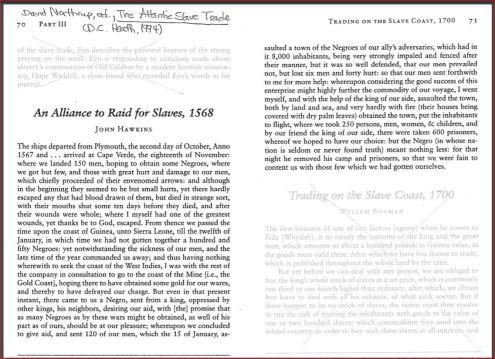John Hawkins, 1532-1595, “was the first Englishman to regularly trade in slaves.” He “pioneered the Atlantic triangular slave trade by being the first merchant to follow the route and turn a profit at each stop.”
“After marrying the daughter of the Treasurer of the Navy, John formed a syndicate of wealthy London merchants to back a new venture trading against Spanish law with the Spanish Colonies in the Americas. These colonies were very short of labour and John Hawkins aimed to take slaves by force in Africa and trade them for the produce of Spanish America. This would produce a double turnover in one voyage. A huge profit would be made.
 [Image, Queen Elizabeth I, 1588, “Armada Portrait Elizabeth I Queens House. “The portrait was made to commemorate the defeat of the Spanish Armada (depicted in the background)” Born 1533, ascended to throne in 1558, died 1603]
[Image, Queen Elizabeth I, 1588, “Armada Portrait Elizabeth I Queens House. “The portrait was made to commemorate the defeat of the Spanish Armada (depicted in the background)” Born 1533, ascended to throne in 1558, died 1603]
He sailed from Plymouth in 1562 with three ships. He violently kidnapped about four hundred Africans in Guinea and traded them in the West Indies for Elizabethan luxuries:- pearls, ginger, sugar and hides. He had become England’s first slave trader. He sailed again in 1564 from the Cattewater (part of the estuary of the river Plym) with four ships. The syndicate this time included Queen Elizabeth I, Navy Board Officers and members of the Privy Council. He violently enslaved around five hundred people in Guinea and traded them in the West Indies [Caribbean]. His personal profit was huge and the Queen gave him a coat of arms. It had a bound slave as the crest.”…
 [Image, A “bound and captive” dark skinned man “in his proper colour” tops the Coat of Arms awarded by Queen Elizabeth I to slave trader John Hawkins, 1/4/1565, “Arms granted to slave trader John Hawkins in 1565, for the massive profits he made in the slave trade. Sable on a point wavy, a lion passant or, in chief three bezants, crest, a demi Moor in his proper colour, bound and captive,
with annulets in his arms and ears. Note the lion in the grant of arms
is described as passant, but in the accompanying illustration is
statant.” College of Arms, United Kingdom]
[Image, A “bound and captive” dark skinned man “in his proper colour” tops the Coat of Arms awarded by Queen Elizabeth I to slave trader John Hawkins, 1/4/1565, “Arms granted to slave trader John Hawkins in 1565, for the massive profits he made in the slave trade. Sable on a point wavy, a lion passant or, in chief three bezants, crest, a demi Moor in his proper colour, bound and captive,
with annulets in his arms and ears. Note the lion in the grant of arms
is described as passant, but in the accompanying illustration is
statant.” College of Arms, United Kingdom]
(continuing): “John Hawkins was responsible for seven ships in two squadrons sailing to Guinea in 1566. Another member of this expedition was Hawkins’ cousin Francis Drake. In 1567, after a service in St Andrews Church attended by the 400 men of his crews, he sailed to the West Indies via Guinea again. After much bloodshed on the Guinea coast 500 slaves were transported to the Caribbean. According to slavers accounts of the time this would probably have involved killing at least three times that number of people. Hawkins made three voyages to what is now Sierra Leone between 1562 and 1569 – enslaving around 1,200 Africans.”…
Added:
Hawkins published a book in 1568, “An Alliance to Raid for Slaves.” An excerpt is provided in David Northrup book, “The Atlantic Slave Trade,” first published in 1994. Hawkins is in Sierra Leone seeking to obtain “Negroes,“ is approached by a local Negro on behalf of a local king who offers Hawkins a deal. If Hawkins and his men will help the local king defeat some nearby adversaries, Hawkins will be given a group of Negro slaves in return. Hawkins agrees but there were complications.
…………………………………..


No comments:
Post a Comment